I decided to post a few more images of our local little ones. . . . . Cannot believe what it’s like to be able to experience this beauty every day! 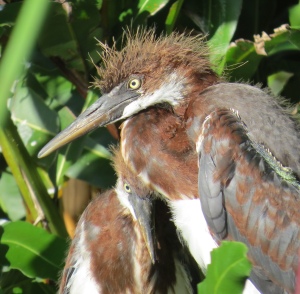 Remember those Tri-colored Heron chicks (above) with the “punk” hairdos? They are getting bigger every day!
Remember those Tri-colored Heron chicks (above) with the “punk” hairdos? They are getting bigger every day!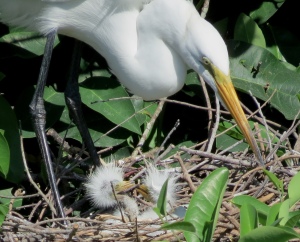
 These are among the newest of the Great Egret chicks – two separate nests, the ones on the bottom are a bit older than the tiny ones in the top photo.
These are among the newest of the Great Egret chicks – two separate nests, the ones on the bottom are a bit older than the tiny ones in the top photo.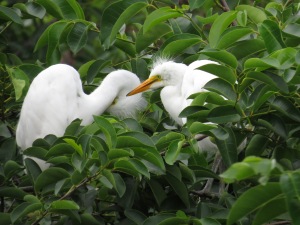 This pair is the older cousins who live next door. They look much more mature already – not as fuzzy! – and don’t make as much noise. ;-D
This pair is the older cousins who live next door. They look much more mature already – not as fuzzy! – and don’t make as much noise. ;-D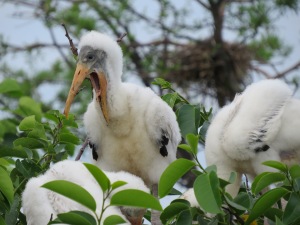 Speaking of noise, the baby Wood Storks are very good at letting their needs be known.
Speaking of noise, the baby Wood Storks are very good at letting their needs be known.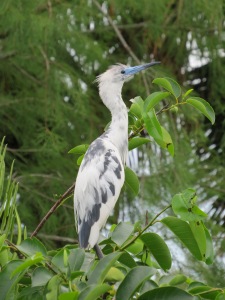 The juvenile Little Blue Heron I saw recently is maturing nicely, as you can see by how much bluer he is getting. The very young Little Blue Herons are all white, with blue beaks, and are often confused for other white wading birds.
The juvenile Little Blue Heron I saw recently is maturing nicely, as you can see by how much bluer he is getting. The very young Little Blue Herons are all white, with blue beaks, and are often confused for other white wading birds.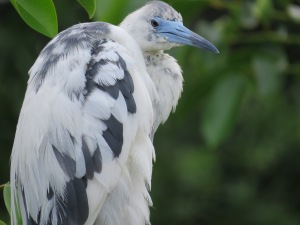 Their plumage becomes patchy blue as they mature over the first year, until their body feathers become fully blue (and the head dark maroon-ish), as adults.
Their plumage becomes patchy blue as they mature over the first year, until their body feathers become fully blue (and the head dark maroon-ish), as adults.
Fortunately for the Little Blue Herons: “During the feathered-hat fashion craze of the early twentieth century, Little Blue Herons’ lack of showy “aigrette plumes” saved them from the hunting frenzy that decimated other heron and egret populations.” (All About Birds)
A note for those who may not be familiar with the “feathered-hat fashion craze of the early twentieth century“:
In the late 1800’s, the magnificent plumes of many waterbirds in Florida and elsewhere, like these Egret beauties above, were highly prized by the women’s millinery industry. Hundreds of thousands of birds were slaughtered for their plumage, and an ounce of their beautiful feathers was so valuable at the time that it was worth more than an ounce of gold!! “Great Egrets were hunted nearly to extinction for their plumes in the late nineteenth century, sparking conservation movements and some of the first laws to protect birds.” (All About Birds) Thankfully, the tireless work of the newly formed Audubon Society and other groups resulted in several laws, including the Federal Migratory Bird Act, passed by the U.S. Congress in 1913, which “outlawed market hunting and forbade interstate transport of birds.” (Read more here)
More excellent information about this tragic time in history – and the sweeping changes that resulted from the advocacy efforts of many citizens – can be found in this archived Audubon Magazine article.





How exceedingly beautiful, what precious images of these newborn vulnerable Egret. I miss spring and all the breeding plumage, it is lovely that it is your season for it and I still get to see it happen there through your wonderful posts:-)
LikeLiked by 1 person
The beauty of blogging with folks who have common interests!
LikeLike
Great photos.
LikeLiked by 1 person
Thank you very much, Pat.
LikeLike
Beautiful bird photos, Bj! Thank you for sharing the info. Yes, thanks to the Audubon Society!
LikeLiked by 1 person
Thanks for visiting, Amy! It really is interesting to read about the early history of Audubon himself, and the Audubon Society. Things have really changed over a century!
LikeLiked by 1 person
❤
LikeLiked by 1 person
Love the little fuzzballs!
LikeLiked by 1 person
They are cute, aren’t they?!
LikeLike